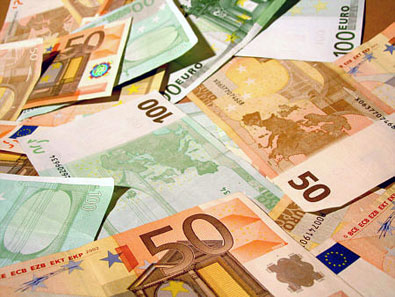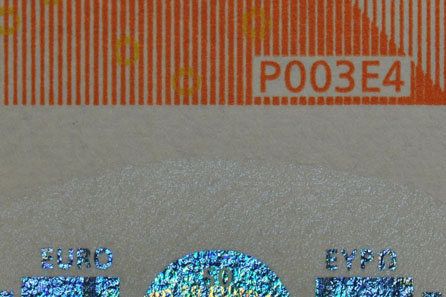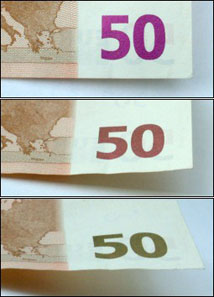January 31, 2013 – On the euro banknotes various symbols are printed that contain important information. We give an overview of the symbols which might be of interest to coin collectors and dealers.
50 and 100 euro banknotes. Source: Friedrich Kromberg / Wikipedia.
If you want to know which country printed the banknote you have to check out the serial number on the banknote’s back. The first character of this number identifies the National Central Bank (NCB) of the country that produced the banknote. The characters W, K and J are not being used yet but have been reserved for EU member states that could adhere to the Euro zone in the future.
After the NCB character follow eleven numbers composed by a ten-digit number and the check sum (1-9). The check sum is the repeated digit sum of the other ten numbers.
National Identification Codes:
Code / Country / Checksum
Z / Belgium / 0
Y / Greece / 1 / initially scheduled for Denmark
X / Germany / 2
W / Denmark / none / not used, initially scheduled for Greece
V / Spain / 4
U / France / 5
T / Ireland / 6
S / Italy / 7
R / not assigned, initially scheduled for Luxemburg
Q / not assigned
P / Netherlands / 1
O / not assigned
N / Austria / 3
M / Portugal / 4
L / Finland / 5
K / Sweden / not used
J / Great Britain / not used
I / not used
H / Slovenia / 0
G /Cyprus / 1
F / Malta / 2
E / Slovakia / 3
D / Estonia / temporarily Finnish euro banknotes are circulating – notes bearing a ‘D’ have not been printed yet
Not all countries printing euro banknotes start their serial number with ‘0000000001’ and carry on the numbering continually, but the numbering systems of the euro banknotes are different. Some countries apply a numbering system which assigns a 1 as starting number to all 5 euro banknotes, a 2 to all 10 euro banknotes and so on. Other countries, however, begin the serial numbers of the 5 euro notes within a range between 063 and 076, the 10 euro banknotes between 077 and 096 and so on. Naturally, the number of combination possibilities influences how many banknotes can be printed.
A portion of the serial numbers is reserved to indicate on which part of the print sheet each note was placed among the up to 60 banknotes. But even this information is encoded differently according to the customs of every country:
D indicates the encoded face value;
N indicates the continuing numbering. This number is applied for every single face value and is increasing uninterruptedly from 0001 on;
P indicates the position of the banknote on the print sheet, using continual numbers for the various possible positions;
X gives the position of the banknote on the x-axis of the printing plate;
Y gives the position of the banknote on the y-axis of the printing plate.
List of the numbering systems:
Code / Country / numbering system / possible combinations in m.
D / Estonia / none
E / Slovakia / NNNNNNNNNN / 70,000
F / Malta / NNNNNNNNNN / 70,000
G / Cyprus / NNNNNNNNNN / 70,000
H / Slovenia / PPNNNNNNNN / ca 54,400
L / Finland / DDDPPNNNNN / ca 3,000
M / Portugal / DNNNNNNNNN / 10,000
N / Austria / XYNNNNNNNN / 35,300
P / Netherlands / NNNNNNNNNN / 70,000
S / Italy / NNNNNNNNNN / 70,000
T / Ireland / UNNNNNNNNN / 10,000
U / France / PPNNNNNNNN / ca 54,400
V / Spain / NNNNNNNNNN / 70,000
X / Germany / NNNNNNNNNN / 70,000
Y / Greece / NNNNNNNNNN / 70,000
Z / Belgium / DPPNNNNNNN / ca 5,180
The printer identification codes indicate the facilities that printed the euro banknote. This code is somewhat hidden on the obverse of the banknote. The first character gives the facility where the banknote was printed. The codes A, C and S were reserved for printers not yet producing euro banknotes (as the following list shows).
Detail of a 50 euro banknote (printer identification code). Source: Wikipedia.
The following three digits state the number of the printing plate or the series. The last two characters of this short code indicate the position of the banknote on the printing plate, from A1 (upper left) to J6 (lower right) according to the printing plate’s size.
Example:
R073H4
- printer: Bundesdruckerei Berlin
- number of the printing plate: 073
- position on the printing plate: eighth from above (H) and fourth from left (4)
List of printer identification codes:
Code / Printer / Location / Country
A / Bank of England Printing Works / Loughton / Great Britain / no banknotes in circulation
B / not assigned
C / AB Tumba Bruk / Tumba / Sweden / no banknotes in circulation
D / Setec Oy (historical) (no banknotes printed before 2003) / Vantaa / Finland
E / Oberthur Technologies / Chantepie / France
F / Österreichische Banknoten- und Sicherheitsdruck GmbH / Vienna / Austria
G / Koninklijke Joh. Enschedé / Haarlem / Netherlands
H / De La Rue plc. / Gateshead / Great Britain
I / not assigned
J / Istituto Poligrafico e Zecca dello Stato / Rome / Italy
K / Central Bank of Ireland / Dublin / Ireland
L / Banque de France / Chamalières / France
M / Fábrica Nacional de Moneda y Timbre / Madrid / Spain
N / Bank of Greece / Athens / Greece
O / not assigned
P / Giesecke & Devrient GmbH / Munich, Leipzig / Germany
Q / not assigned
R / Bundesdruckerei / Berlin / Germany
S / Danmarks Nationalbank / Copenhagen / Denmark / no banknotes circulating
T / National Bank of Belgium / Brussels / Belgium
U / Valora SA (Banco de Portugal) / Carregado / Portugal
Colour change of a 50 euro banknote if tilted. Source: Anton / Wikipedia.
In order to prevent counterfeiting the euro banknotes are additionally provided with so-called security features like watermarks, security threads, microprinting, glossy stripes, bar codes and so on.
More information on the euro is available on the ECB website.
This article is based on the extensive material offered by the excellent Wikipedia article ‘euro banknotes’, that we recommend to your attention.






